Feature Interview with Greg Ohlendorf
July, 2021
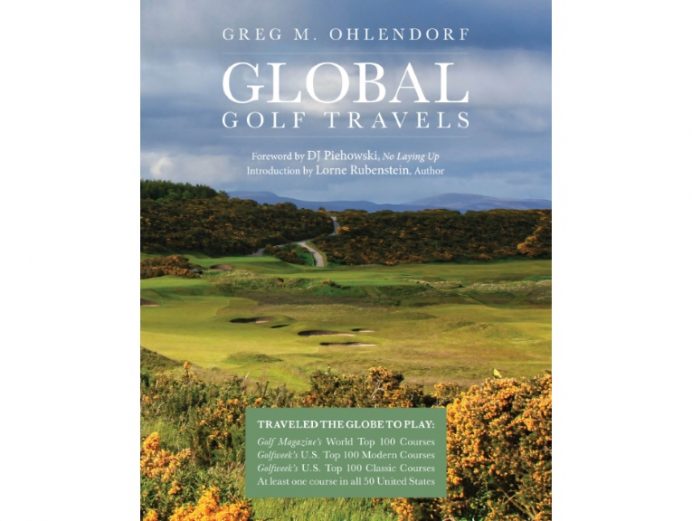
From his beginnings at Shady Lawn Golf Course outside of Chicago, Illinois, Greg Ohlendorf enjoyed the process of getting on and playing other local courses. In the mid-1990s, he joined Idlewild CC, his first experience at club life. Two years later, he fell in love with Flossmoor Country Club (now Flossmoor Golf Club), an 1899 design by Herbert Tweedie. It was there that he was first exposed to true classic architecture, especially how important green complexes are to a course’s soul. In 2000, his wife and he headed across the pond, and did so again for the next five years. At this point, he was hooked on golf course architecture and the art of exploration. In 2004, he became a panelist for Golfweek Magazine and has now seen over 1,000 courses in 16 countries. Global Golf Travels is his first book and may be purchased here: Global Golf Travels.
1. What prompted you to write Global Golf Travels? What do you hope the reader will glean from it?
It started as a memoir to my family, and specifically for my grandson or granddaughter, who at the time I began, wasn’t even a figment in my son and his wife’s imagination. I realized, though, that I knew so little of my grandparents’ lives that I wanted to leave something in writing for a future generation to read. Whether or not they cared about golf was secondary, but I thought they might like the “wanderlust” traveler part of my adventure.
I didn’t expect that I would turn it into a book, and I recognize that my writing is not exactly on par with John Steinbeck, but a friend of mine convinced me that there would be an audience for it. He said that there are many people chasing lists and courses around the US or the world. Still, for one reason or another (money, time, connections, or an understanding spouse), they would never be able to finish their adventures and that they might enjoy reading my tale vicariously.
I hope the readers enjoy my journey, but most importantly, I hope they have a passion in life and chase after it. I have learned the hard way that life can be way too short, and putting off to tomorrow might be a mistake.
2. Your Dad lost his battle with Alzheimer’s before you started world travel at 36 years old. Is one primary takeaway from the book don’t wait for tomorrow what you can do today?
Absolutely. My Dad ran a funeral home and ambulance company with my mom for decades. He helped people in their time of need thousands of times. We missed more holiday dinners than I could count as we ran ambulance calls constantly (I was an EMT for almost 20 years myself). These were 24/7/365 businesses, and we didn’t get to travel much until way later in life. Once Dad was diagnosed, even that limited travel was scuttled. Carpe diem became my motto after Dad died.
3. How is the book organized?
I thought about the organization a great deal but ultimately decided to tell my story chronologically. Each “hole” or “chapter,” after the first one, is a year of my travels. I started with my first trip to Scotland in 2000, which I took with my wife, son, and mom, only a few months after my Dad died. I made sure that I covered, even if briefly, each of the courses I played from the 2010 Golfweek Top 100 Modern and Top 100 Classic courses, plus the 2011 Golf Magazine Top 100 World list, plus the courses that completed my playing in all 50 states. To the best of my knowledge, I’m only the second person to have done all of the above. But I wanted to make sure I gave some space to some special courses that weren’t on any of these lists.
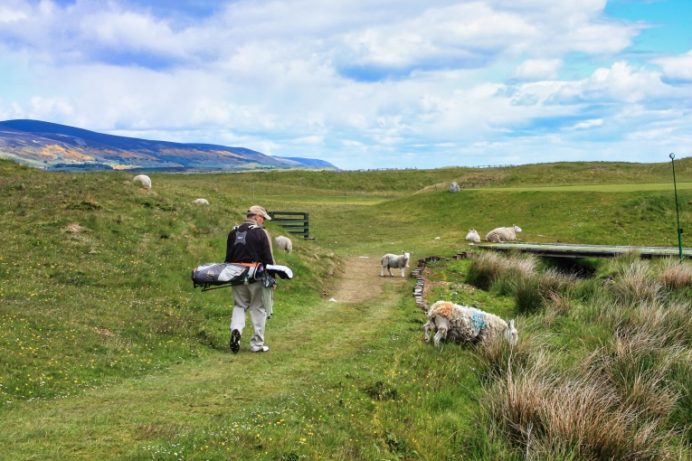
Brora, about a 30 minute drive north of Dornoch, possesses better architecture and offers a more memorable playing experience than plenty of bigger name links.
Over the years, I have seen over 750 of the courses on the Golfweek ballot (and over 1,000 total), and trust me, they are not all epic. Playing Cape Arundel, the fantastic Walter Travis course in Kennebunkport, Maine, or the nine-holer, Durness Golf Club in Durness, Scotland, was more memorable than some of the courses on the lists I completed.

Regardless of how many courses you see, the epic 9 holer Durness rests favorably in the mind.
4. Compared to the rankings that you used as guides, how did your opinion vary having actually played the courses? Did patterns emerge where you favored certain type courses higher than their “rankings”? Conversely, did certain types leave you a bit mystified?
Following a list has its advantages and disadvantages. On the positive side, it’s a good place to start as you have some direction as to what “others” think is great. On the negative side, it’s based on other’s opinions and their definition of great may or may not equal your own. Early on, I questioned certain courses, but felt that maybe I was missing something since I didn’t have enough experience to truly judge greatness. There are courses all over the country or world in very different climates, with very different grass types, and obviously I did not see all of them during their peak season. I worked hard to normalize such factors.
Additionally, following the stated “criteria” of any rating panel is only a starting point. I discovered that exceptional greens are a major factor in determining a course’s greatness. If you shoot a round of par (72), 36 of those shots should be on the green. What is worse than seeing 18 of them, that fall from back to front and the most break you read on any of them is 6-7 inches. I don’t want to be bored on half of my shots.
As a result, my “home” courses today all have great green complexes as part of their design: Prairie Dunes, Pinehurst #2, Royal Dornoch, Flossmoor, Mid Pines and Pine Needles. You can’t fall asleep on any of these courses when on or near their greens.
I did begin to notice some courses that were under appreciated and not on anyone’s list, but would have certainly been on mine. Rolling Green in Philadelphia and Whippoorwill Club in Westchester County, NY were a couple of noteworthy examples. What I realized was that both were in the shadows of some incredible neighboring courses. Think of the tremendous Philly and Westchester County tracks. Really good courses were being overlooked because of the great courses down the road.
After all of the time I have studied golf course architecture and the miles I’ve driven or flown, I also started to realize that some “list” courses didn’t seem to fit, or not at least as highly as they were currently rated. My buddy Ben Klaas (who did all of my extended overseas trips with me over the last half decade), and I were driving down a two lane road in rural New Zealand in November, 2016 when this conversation came up. We made a list of those factors that we felt caused a course to be overrated, and I still have that note on my phone today.\
Here is our list (and I say “our” because Ben deserves “credit” for these thoughts too):
1) An otherwise mundane course that is near a large body of water
2) The childhood home of a major champion
3) The course has hosted a PGA tour event or a major championship on multiple occasions
4) The course is hard to get to or very difficult to get a tee time (or both)
5) A course that plays over 7,500 yards from the tips and has a huge slope and course rating
6) The circuses, including the clubhouse, locker room, or other amenities are amazing (including man-made waterfalls)
7) A project that has taken years to develop but the hype has never died down
8) A course by “x” famous architect, so it has to be good by default
9) A spectacular maintenance budget
10) A course that has one member
And on the flip side, underrated courses are likely to be…
1) Built by a non-famous architect
2) Located far from major travel patterns or cities
3) Lacking a big maintenance budget which might hurt day to day conditioning
By the way, just because a course might be one of the above doesn’t make it overrated/underrated, but some certainly are.
5. Congratulations for making golf travel and family time be synonymous. How did that come to pass?
I lost my Dad way too young. I was the third child of three, and my sisters are 11 and 14 years older than I am. My mom lost a child between my second sister and me. I didn’t get as many years with my amazing father as I would have liked. As a result, I wanted to make this journey as much about family as I could. Melissa, my wife, has been a staunch supporter of my adventures from the beginning. She was on all of my early trips. Then my nephew, Clint, made the next trips with me all across the country, and my son, Cameron, started to travel and play on the trips as soon as possible. He became the youngest Golfweek rater at the time, as he understood the architectural significance of the courses we were playing as we discussed each in detail on the way back from our travels. Having family along on most of my trips made much of this doable and far more enjoyable than traveling independently.
6. After marrying Melissa in 1985, Blackwolf Run was your first experience of playing a world-class course. Tell us about it, noting that this was the original routing before holes were peeled away for the Meadow Course. Where would you put the original Blackwolf relative to Dye’s best?
We were dirt poor when we got married. I had a very modest paying job at my bank, and Melissa was still student teaching. We rented our house and a car from my parents and thankfully, they didn’t charge us much. A couple of years after we were married, Melissa said we needed to take a vacation. I wasn’t sure how we could afford it, but she convinced me we could. We spent a night in Milwaukee, a second in Port Washington, Wisconsin, and the third was to be at some new place I had never heard of called The American Club in Kohler, Wisconsin (Melissa’s high school conference included Kohler High School, and she had seen the very beginnings of the transformation of the Kohler dormitory into the five-diamond American Club). She even said that I could play the new golf course they were building there. I had no idea what she was talking about, but I went with the program since golf was involved.
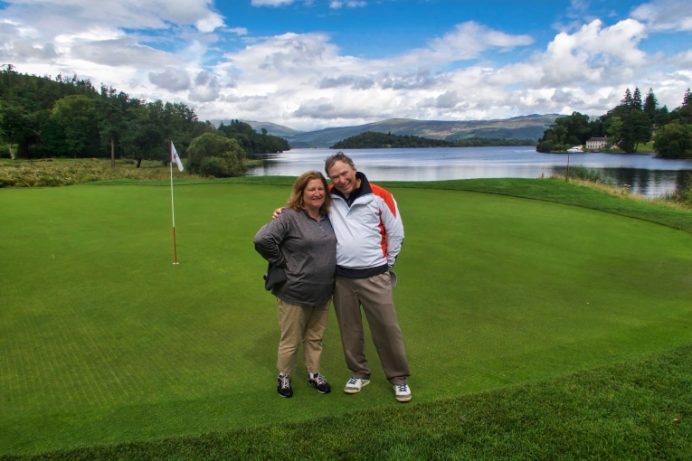
Greg’s most frequent golf companion? His wife, Melissa, shown here together at Loch Lomond.
Seeing the original routing of Blackwolf Run blew me away. I had never seen anything like it, and I thought that Pete Dye had done a fantastic job routing an exceptional course on the Kohler property. Frankly, I think the original routing is even better than the current, as the holes that went to the Meadow Valley course may have been some of the best in that design. All in all, that original course is a top-five Dye course, in my opinion.
Next up was another summer vacation, this time on Hilton Head, including Harbour Town. Pretty cool that the same man built both courses as they couldn’t occupy more different land.
7. As you started seeing more and more, is that when the light switch went on for studying architecture?
So, it’s crazy that Harbour Town was next (and again, it was Melissa’s idea, which is why my chapter on all of this is called “It’s All Melissa’s Fault, and She Knows it!”). She wanted to go where the tour played near the candy-striped lighthouse, and I thought that was a grand idea. Seeing this Dye layout, which was so different than Blackwolf Run, was eye-opening. How could someone successfully build two excellent courses on two very different properties and make them both work? I wanted to learn and understand more about golf course architecture.
8. You organized your first UK trip in 2000, booking through a travel agent. Over the ensuing 20+ years, technology has changed quite a bit. How do you now book trips?
A golf travel company booked our first two trips across the pond as we had no idea how to do it. We paid dearly for the privilege. When we decided to go back for the third year in a row (and ultimately six years in a row), Melissa was convinced that we could make all of our travel plans on our own. This was 2002. I had my reservations, but she was determined to do it. We made our routing and got up early to make the trans-Atlantic calls to make our tee times and hotel/B&B reservations. Everyone we called was so friendly and accommodating that we wondered why we hadn’t done this in the first place.
I have only used a travel agent one-time since (for the Japan portion of my Far East Asia itinerary). While some of my later trips were far more complicated (like playing in South Korea, Japan, China, Viet Nam, and Thailand on the same trip), all of them have worked better than anyone could have predicted. That particular trip required six months of planning, but it was truly worth the effort. I enjoy the challenge of making plans almost as much as playing the courses.
9. Tell us about Cam and you at Gleneagles and ‘pressing on.’ It’s a great father-son experience.
My son, Cameron, made five of the first six “across the pond” trips. He was 10 for the first one when we visited Gleneagles. I think he enjoyed walking along the great links courses as much as I did. He loved finding wayward golf balls in the long grasses that aligned the fairways. He often got “tipped” by my playing partners after we finished for helping along the way.
At Gleneagles Queens, we were only a few holes out when a torrential downpour came. I asked him if he wanted to go in, but he replied, “no way.” He wanted to see me finish my round even if our umbrella had turned inside out a dozen times. I knew I had a “mudder” right then and there. Fast forward, but once he started playing competitively in school, he played better the worse the weather was. When other kids gave up, Cam trudged on. I think it all goes back to our round at the Queens.
10. Please share with us about your 20-year-old caddy on the New Course at St. Andrews and how he enhanced your round there, followed by increasing your knowledge of The Old Course and then even expanding your overall experience at St. Andrews.
My three days with my caddie at St. Andrews are some of the best. Having a young caddie club me after three holes was amazing, and having him tell me that he could do it because he was just “playing his own ball” was so cool. He was the medal player at St. Andrews University at the time, and him suggesting that I played somewhat like him was flattering. Then, having him set me up with his benefactor, who was an R&A member, and getting to go inside one of the most famous buildings in golf was surreal. Having a local caddie can be a genuine plus when playing in GB&I, and this experience confirmed it.
11. Dunbar grabbed your fancy, yet too few Americans routinely include it. What are some highlights people can expect?
Hidden gem has unfortunately become an overused phrase, but trust me, there are some true hidden gems worldwide. Dunbar Golf Club is one of them. I have told people over and over that just playing the rota courses is a mistake. First, it’s become costly, but second, one will miss some great courses along the way. Dunbar isn’t on many people’s agenda when it sits in the shadow of Muirfield, North Berwick, and even maybe Gullane or The Renaissance Club, but Dunbar is a treat. After the first four holes near the clubhouse, you head down the coast toward a lighthouse and then back to the clubhouse. The course flows so naturally down the shoreline that all that matters is the golf. It’s peaceful and serene, and that’s what makes our game so great.
12. You deem Enniscrone a ‘must-play’ for anyone heading to Ireland. Please elaborate.
Enniscrone is a “must play,” but so are Carne, Rosses Point, Ballyliffin, etc., up the west coast of Ireland. Missing the trip north from Shannon, through Northern Ireland, and back down to Dublin means you missed Ireland. So many people make the trip around the south and never head north of Lahinch. That’s a huge mistake, one that I am sure that the opening of St. Patrick’s Links in County Donegal will help soon change. The west coast golf is excellent, the prices are amazing, and the people are lovely. The dunes at Enniscrone and Carne are epic, some of the most spectacular in the game. That, and the fact that there are no tour busses, makes Ireland’s western and northern coasts “must plays” for any serious golfer.

Father and son at Enniscrone in 2003.
13. Tell us about the ‘Open’ round at Castlerock. Do you think that would happen in America?
When I called Castlerock, a course many might skip in Northern Ireland, the lady who answered told me that on the day I was requesting, they were hosting an “Open.” I said that I understood and that I was sorry I couldn’t play (as the other days in my trip were booked). She then said that I could play in the “Open,” which would cost me 10 pounds. This simply didn’t compute for me. How could I play on the day they had an event and pay only 10 pounds? I wasn’t a member. After a bit more back and forth, I finally understood that an “Open” was like the most incredible guest day in the world. Getting to play in a competition in a foreign country for basically free was a great experience. Can you imagine playing Shinnecock for $20 as a guest in a competition?! I wish our US courses opened up for a day or two a year in the same fashion as they do in GB&I. It’s a unique way to experience a course.
14. Similarly, one strong recommendation is to avail yourself of playing club matches in the UK. Tell us of one of your favorite playing experiences.
I had the chance to play a weekend of matches at the very end of my journey at Royal Cinq Ports, a genuinely underrated track near Royal St. George’s. My home club in Chicago, Flossmoor Golf Club, has a reciprocal arrangement with Cinq Ports. The guys from there came over to America in 2009 to play the courses that had hosted major championships the same years they had (the 1909 and 1920 Open). Flossmoor had hosted the 1909 Western Amateur and the 1920 PGA Championship, so we were one of the courses they visited. We had a blast, and the Cinq Ports guys wanted us to come and play matches with them the following year. We didn’t get that together, but on the 10th anniversary in 2019, a fellow member friend of mine and I got a group of guys together to make the trip over. We had an epic weekend of golf, drink, and revelry that I will long remember. Matches are the lifeblood of GB&I courses, and getting to join in one is a must-do. I need to add that Team Flossmoor has bested Team Cinq Ports on both occasions!
15. You freely call Dornoch your ‘favorite course in the world.’ What makes it so?
I fell in love with Dornoch on my very first trip around it. The way it routes, with each of the first half dozen holes going “out” but at slightly different angles, made me realize that there was so much more to links golf and its associated wind. The tight turf, the revetted bunkers, and the fantastic green sites just caught my imagination. Dornoch is a collection of short holes that are beguiling (like number 2) with epic par fours like number 14, Foxy, that I have yet to figure out after dozens of rounds, honestly. It’s not a bombers course, but if you still need to drive the ball well. You may hit driver, three wood, hybrid, and five iron during the round off the tee. There are only a handful of courses that I feel that I’d want to play over and over, and Dornoch is at the top of that list.
16. What are three out-of-the-way places that you are thrilled to have been that might be off most people’s radar?
Shanqin Bay on Hainan Island in China, Tara Ita near Aukland, New Zealand, and Durban in Durban, South Africa all fall in the “I can’t believe I’m here category.” My day at Shanqin Bay was indeed off the chart. This Coore/Crenshaw track is an excellent test of golf in a place I never thought I’d be. The day I played there, the Chinese premier was five miles down the road at the Far East Asia summit, and Chinese warships were patrolling off the coast of the course. That, and the fact that I had to send away my US passport to the Chinese government for ten plus days to get a Visa, made for a memorable adventure.
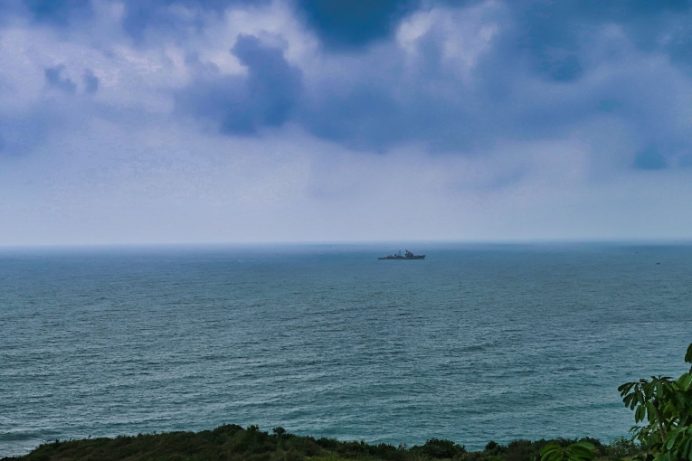
The passing of a Chinese warship only added to the playing experience at Shanqin Bay.
I saw Tara Iti not long after it opened. I’d read the hype about this new Tom Doak course, but as the years rolled on, I became more and more suspect of the advanced reports of courses. Not five minutes after I teed off, I knew that Doak had built a fantastic course on an amazing piece of property. I saw golf holes in every direction that I looked and wanted so badly to play cross-country golf, using any tee box and playing to a random green across the dunescape. This was a guaranteed Top 50 course in my mind, and I enjoyed getting to experience it early in its existence.
And lastly, Durban. While it’s no longer World Top 100, I never thought I would get to go to South Africa in my wildest dreams. I knew the history of the country and the struggles they had endured and still endure. As far as the course goes, I had read about the first five holes, which were noted as exceptional, but a guy from Beecher, Illinois, doesn’t fly to South Africa to play golf. Getting there from London by taking two overnight flights over two days was crazy but so wonderful at the same time. Looking out the plane window while over Africa and seeing no lights anywhere was hard to comprehend. Durban is a tough town, and my host gave me a tour on the way back to the airport. I saw an economy that is struggling to make it. I also saw a pretty good golf course. I’ll never forget those 48 hours.
17. You consider one of the best days in golf to be in France. Explain.
France isn’t one of most people’s golf destinations. Morfontaine should be, and maybe for the nine-hole Valliere course as much as for the highly-rated 18-holer. France is a lovely country for so many reasons, but most think of art, architecture, and wine, far before golf. My day included 27 holes at Morfontaine (on a day that was over 100 degrees) and dinner with Melissa at a three Michelin star restaurant (plus a drive past the Arc de Triumph with our guide through the maniacal traffic). I’m not sure what could beat that (maybe 36 spilt between Shinny and National), but no one has offered me that opportunity!
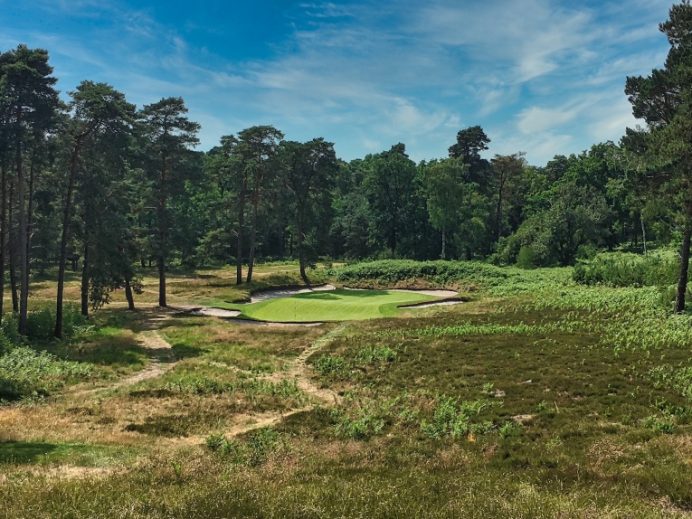
Well removed from the bustle of Paris, Morfontaine’s architecture and ambience are both sublime.
18. Two ways to doom a trip are to travel with the wrong people and build in too much. What are some other, more subtle things you have learned to avoid that have helped your travels go well?
You have indeed noted the two biggest mistakes of golf trips. I learned early that who you traveled with has a significant influence on how well the trip would go. I learned some simple rules…1) we would play a lot of golf, so anyone going along needed to understand that and be in good enough shape to handle it; 2) golf was the priority, and extracurriculars couldn’t impact the trip (8 am tee times meant being on the tee at 8 am); 3) the travel could and would be exhausting at times (I just didn’t have endless vacation days so 36 a day was normal); and 4) even if you weren’t playing well, you have no right to ruin the trip for others.
I quickly realized that someone has to be “in charge” of the trip. A benevolent dictator travel planner is a must. Big trips with an aggressive itinerary need a ton of planning and organization, and someone needs to “own” that. The others need to respect that and go along with the program. What that ended up meaning is that Cam, Clint, and Ben became my travel buddies for the majority of my trips as they completely understood the “rules.” I planned many of our trips, but I happily went along with the plans if I didn’t.
19. Were there any places on your journey where golf was secondary to the balance of the experience?
Absolutely, and the one that stands above the rest was my time in Viet Nam. Ben and I made a Far East trip that included South Korea, Japan, China, Viet Nam, and Thailand. There are some excellent courses in this region, but we truly enjoyed the adventure of travel from country to country equally. Viet Nam was someplace I never thought I’d visit, but anyone from my generation or an earlier generation certainly was affected by the war fought there. I can remember watching the reports on television as I grew up, and those images were still very much in my mind. When we landed in Ho Chi Minh City, we needed to clear customs and secure a Visa. They offer something called a “Visa on Arrival” in Viet Nam, so we had completed the paperwork and hired a local company to lead us through the process. Let’s just say the worst line you have ever waited to clear TSA PreCheck was far more efficient than getting a Visa on Arrival in Viet Nam.
After a couple of hours, we finally headed to find our driver, who would take us through the city and out to the coast to get to The Bluffs at Ho Tram Strip (a Greg Norman design). The drive, although only 73 miles, took us 2 ½ hours. Seeing the fledgling economy in downtown Ho Chi Minh City was remarkable. We watched scooters (some with four people on them) careening in eight different directions with no traffic lights or rules, for that matter. We assumed we see crash after crash, but somehow, it all worked. On the outside of the city, some very modern developments were springing up.

Golf is a great mechanism to explore places that you might otherwise never have gone.
And further down the road, we saw the rice fields where our young men and women fought. This was all amazing to witness and pretty poignant at the same time. The course we played the following day was fine, but nothing special. A trip to Viet Nam, though, is memorable.
To purchase the book, please visit Global Golf Travels








